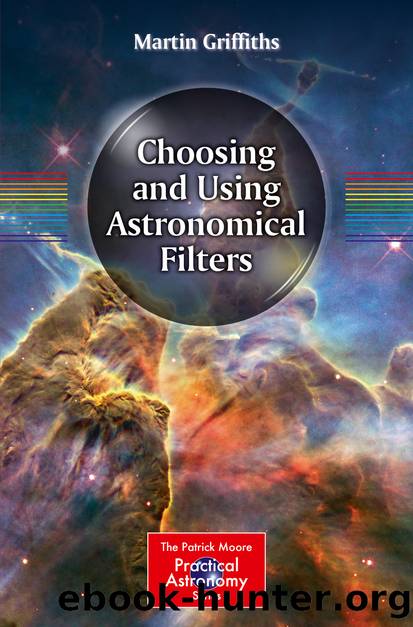Choosing and Using Astronomical Filters by Martin Griffiths

Author:Martin Griffiths
Language: eng
Format: epub
Publisher: Springer New York, New York, NY
One does not need a very large telescope to observe these details. Most observers use a 60-mm telescope or smaller, as the Sun is very large and relatively close as an astronomical object. Coronado, Solar Scopes and Lunt telescopes have small ranges of between 40 and 100 mm, which are more than adequate to observe our nearest star.
Additionally, it is very easy to take photographs through Mylar or Baader paper and then reduce them in Photoshop to gain better contrast and even add color to them. This can be done with a monochrome shot through such filters by the simple expedient of going into Photoshop and going to image > mode > RGB color. Once RGB color is ticked then go to enhance > adjust color > adjust hue/saturation and tick the colorize box at bottom right. Use the sliders then to get the correct color hue and lightness and saturation before going off to adjust the image under enhance in other ways. Other software packages will have slightly different menus, but the method is similar. Figure 5.3a show the difference such coloration can make.
Fig. 5.3Baader paper eclipse (a) and Photoshop colored version (b) (image taken by Martin Griffiths)
Download
This site does not store any files on its server. We only index and link to content provided by other sites. Please contact the content providers to delete copyright contents if any and email us, we'll remove relevant links or contents immediately.
| Circuits | Digital Design |
| Electric Machinery & Motors | Electronics |
| Fiber Optics | Networks |
| Superconductivity |
Whiskies Galore by Ian Buxton(40332)
Introduction to Aircraft Design (Cambridge Aerospace Series) by John P. Fielding(32338)
Small Unmanned Fixed-wing Aircraft Design by Andrew J. Keane Andras Sobester James P. Scanlan & András Sóbester & James P. Scanlan(32141)
Craft Beer for the Homebrewer by Michael Agnew(17446)
Turbulence by E. J. Noyes(7039)
The Complete Stick Figure Physics Tutorials by Allen Sarah(6638)
Kaplan MCAT General Chemistry Review by Kaplan(6054)
The Thirst by Nesbo Jo(5785)
Bad Blood by John Carreyrou(5769)
Learning SQL by Alan Beaulieu(5412)
Weapons of Math Destruction by Cathy O'Neil(5037)
Man-made Catastrophes and Risk Information Concealment by Dmitry Chernov & Didier Sornette(4736)
iGen by Jean M. Twenge(4702)
Digital Minimalism by Cal Newport;(4542)
Life 3.0: Being Human in the Age of Artificial Intelligence by Tegmark Max(4507)
Audition by Ryu Murakami(4099)
1,001 ASVAB Practice Questions For Dummies by Powers Rod(4038)
Electronic Devices & Circuits by Jacob Millman & Christos C. Halkias(4027)
Pale Blue Dot by Carl Sagan(4001)
